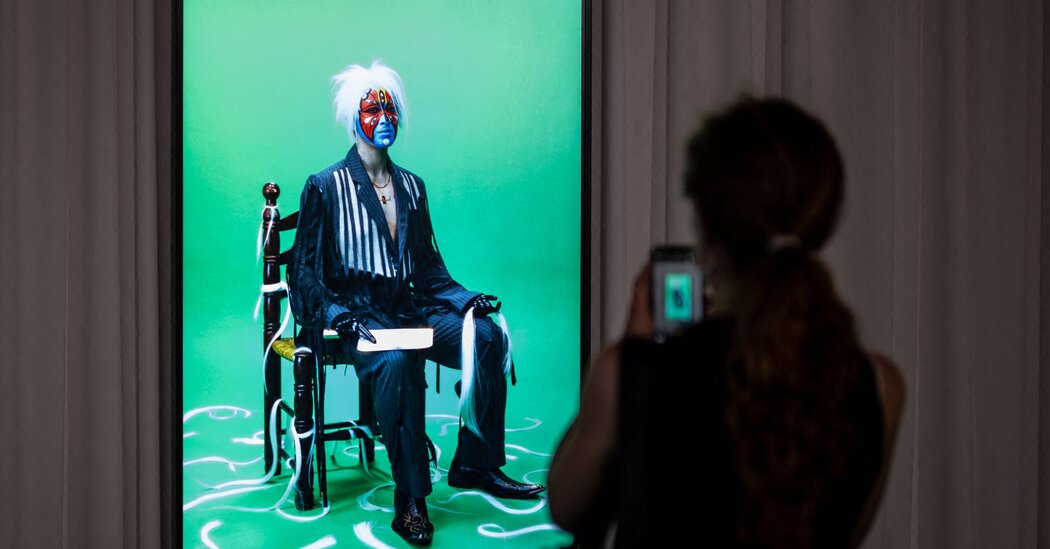After a disappointing run of auctions in New York in May, dealers exhibiting this year at Switzerland’s Art Basel fair – which opened to VIPs on Tuesday and welcomes the general public from Friday – hoped to allay concerns about a dip in the art market .
The 53rd annual edition of this Swiss event, featuring 284 international galleries specializing in 20th and 21st century art, was the first overseen by Art Basel’s new CEO, Noah Horowitz. It is being held in a climate of geopolitical uncertainty, with high interest rates and inflation hampering consumer spending in many countries.
“There’s quite a bit of fear,” says Paul Gray, the director of Gray Gallery, based in Chicago and New York. But in his 40 years of experience, he added, the art market has suffered some major downturns. “Serious collectors keep buying,” he said.
The stands of the top international dealers at this year’s Art Basel feature several trophy-level works on consignment from private collections. In recent years, auctions have often been the go-to channel for such sales, so their presence indicated that certain wealthy collectors were devising other strategies.
For example, Acquavella Galleries exhibited Mark Rothko’s 1955 excerpt, “Untitled (Yellow, Orange, Yellow, Light Orange)”, from an American collector, priced at $60 million. Hauser & Wirth offered a 1996 Louise Bourgeois “Spider IV” bronze for $22.5 million, while Pace presented Joan Mitchell’s 1963 “Girolata Triptych” for $14 million.
According to their galleries, the last two works had both found buyers by Wednesday morning.
“The sellers who want their price try here, rather than see their work sold at auction at a low price or lower,” says Wendy Cromwell, a New York-based art consultant, explaining why some owners chose to sell at Art Basel, rather than Sotheby’s or Christie’s.
“We’re up 40 percent from last year,” gallery owner David Zwirner said Tuesday. The relaxation of coronavirus prevention measures had played a major role, he added.
“Asian collectors are here. They can travel without restrictions,” Zwirner said. He estimated that 20 percent of his first-day sales were to Asian customers. “The last auction cycle has also helped,” Zwirner added, referring to New York’s subpar sales in May. “People complained about the results, but it resets the market. Owners no longer charge unrealistic prices. That makes it easier to sell.”
“Graduation,” a haunting 2015 painting by American artist Noah Davis, was one of Zwirner’s many first-day sales for $2 million, according to the gallery; a spokesperson for White Cube said the gallery had sold another Davis painting, “Pueblo del Rio: Vernon,” from 2014 for $2.75 million. The demand for works by Davis, who co-founded the Underground Museum in Los Angeles before his untimely death in 2015, is part of a more general reorientation of the market toward works by artists of color and women who explore Art Basel and other art. has transformed. world events in recent years.
In a new section of the fair called Feature, dedicated to solo presentations of works by 20th-century artists, Dutch painter and writer Jacqueline de Jong, 84, was on hand to talk about her experiences in the Situationist International movement in Paris. the sixties. where she made violent expressionist paintings. London dealer Pippy Houldsworth presented six of De Jong’s canvases from the 1960s in Feature, four of which had sold on Wednesday, for between €110,000 and €165,000, according to the gallery.
“I don’t like the word ‘rediscovered’. It makes me feel older than I am’, says de Jong, whose paintings are currently on display in two museum exhibitions in the Netherlands. “Still, recognition at this age is great.”
But, as always, collectors were also looking for new work by young ‘rising star’ artists, whose values can be on a steep upward trajectory. At least 10 collectors bought samples of “Portraits” by Canadian artist Sin Wai Kin, 32. These gender-fluid digital works, inspired by Cantonese and Peking Opera roles, were offered by London gallery Soft Opening and cost between $7,000 and $18,000. Liza Lacroix, 35, a fellow Canadian artist, sold a new abstract painting at the booth of Gisela Capitain, a dealer from Cologne, Germany, for $36,000.
By Friday, some of the top dealers had already released lengthy sales lists. But for other exhibitors, the hustle and bustle of collectors, consultants, and curators didn’t translate so easily into handshakes and invoices.
“I witnessed more conversations between gallery owners and fairgoers than usual. I haven’t seen any actual transactions,” says Michael Short, a Berlin-based art consultant and curator. “When asked, most of the gallerists told me they were ‘breaking even,'” Short added. “No one panicked, but no one was overly pleased.”

